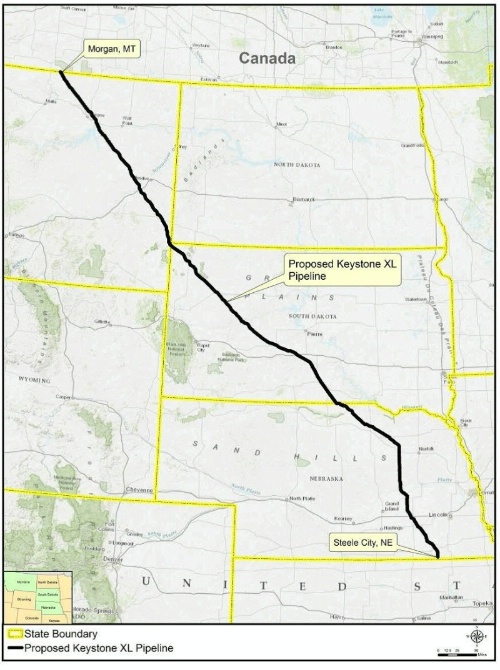
Source: U.S. State Department
The final SEIS concluded that whether or not Keystone XL is built, the impact on extraction in the Canadian oil sands region will not be significantly affected. That conclusion is based on expected oil prices, oil-sands supply costs, transport costs, and supply-demand scenarios examined in the SEIS.
The SEIS also concluded that the pipeline’s impact on carbon dioxide emissions would be relatively small. U.S. CO2 emissions from burning petroleum totaled about 2.2 billion tons in 2012 and the U.S. Energy Information Administration estimates that 2013 emissions will reach approximately the same level. According to the final SEIS, lifecycle emissions (i.e., production, refining, and combustion) from the 830,000 barrels of crude a day that would flow through the Keystone XL pipeline would add 147 to 168 million tons annually. That’s an increase of about 6.7% to 7.6% in carbon emissions from burning petroleum products.
Estimated U.S. carbon emissions from all sources in 2013 totaled about 5.3 billion tons, which would about halve the increase from the Keystone XL pipeline.
How significant is that? The U.S. has lowered its carbon dioxide emissions by a total of about 10% since 2007. President Obama has set a goal of a 17% reduction by 2017, a goal that will be much harder (impossible) to reach if Keystone XL volumes are added in. But because construction of the pipeline will not affect production from the oil sands, that 3% to 4% of added emissions will not change. The only difference is that the U.S. will not be directly culpable in adding carbon dioxide to the earth’s atmosphere.
In November I suggested that the Keystone XL project was dead because the pipeline is really no longer necessary to move oil sands production to U.S. Gulf Coast refineries or export terminals. Refiners have plenty of supply and transporting Canadian crude more than 1,100 miles across the U.S. only to export it to foreign buyers could be a tough sell to voters because the U.S. would realize little benefit from the pipeline.
The jobs-creating argument for the pipeline is not as compelling either, now that double-digit unemployment is behind us. During the two-year construction period the SEIS estimates 3,900 full-time jobs would be created and another 38,200 indirect and induced jobs. Only about 50 permanent jobs would result after the Keystone XL is operational. Construction would contribute about $3.4 billion to U.S. GDP, about 0.02% of annual U.S. GDP.
Most coverage of the final SEIS has focused on how the review generally supports construction of the pipeline. The President has said that his main consideration for approving or rejecting the pipeline is whether Keystone XL will add significantly to the amount of carbon in the atmosphere. Global carbon emissions in 2013 have been estimated at 36 billion metric tons, so the addition of a few million more would likely be offset by declines in consumption of other fossil fuels.
The catch, though, is that the President’s goal for a reduction of U.S. emissions by 2017 would almost certainly not be met. Obama could easily argue that permitting construction of the Keystone XL pipeline does add significantly to U.S. emissions and, therefore, he will not approve construction. Politically that would raise his credibility with environmentalists and could be a big boost to the next Democratic nominee for President.
Nothing in the documents released yesterday is a real game-changer. From where I sit, the Keystone XL is still more likely to be rejected than approved.
Sponsored: Want to Retire Early? Here’s a Great First Step
Want retirement to come a few years earlier than you’d planned? Orare you ready to retire now, but want an extra set of eyes on your finances?
Now you can speak with up to 3 financial experts in your area for FREE. By simply clicking here you can begin to match with financial professionals who can help you build your plan to retire early. And the best part? The first conversation with them is free.
Click here to match with up to 3 financial pros who would be excited to help you make financial decisions.
Thank you for reading! Have some feedback for us?
Contact the 24/7 Wall St. editorial team.


